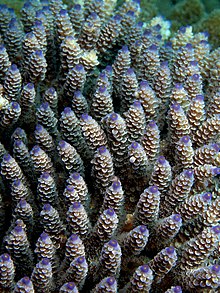Acropora secale
| Acropora secale | |
|---|---|

| |
| Scientific classification | |
| Domain: | Eukaryota |
| Kingdom: | Animalia |
| Phylum: | Cnidaria |
| Class: | Hexacorallia |
| Order: | Scleractinia |
| Family: | Acroporidae |
| Genus: | Acropora |
| Species: | A. secale
|
| Binomial name | |
| Acropora secale (Studer, 1878)[2]
| |
| Synonyms | |
|
List
| |
Acropora secale is a species of branching staghorn stony coral. It is found in shallow parts of the Indo-Pacific Ocean and the type locality is Sri Lanka. The oldest fossils found date back to the Pleistocene.[3]
Description
Acropora secale is a colonial coral that forms low hummocks. The branches can grow to a diameter of 20 mm (0.8 in) and length of 70 millimetres (2.8 in). They are cylindrical but gradually taper towards the tips. They grow in a corymbose fashion with the lower branches being longer than the upper ones so that the coral has a level-topped appearance. The corallites are of varying sizes and arranged in vertical rows, often with alternate rows of larger and smaller corallites.[4] The axial corallites are up to 3 millimetres (0.12 in) in diameter while the radial corallites either have long tubular openings or nariform (noselike) openings. The skeleton is covered by a thin ectodermal layer of tissue. When feeding, the polyps protrude from the corallites. Each has a single ring of twelve tentacles, one of which is longer than the others. The polyps have a mouth which opens into the coelenteron. This interconnects with other polyps through a complex system of channels, the coenenchyme, inside the porous skeleton.[3] Several colour schemes occur in this coral, purple with yellow tips to the branches, pale brown with blue tips, plain green or plain brown.[3]
Distribution
Acropora secale is found in the tropical waters of the west Indo-Pacific including the coasts of East Africa, Mozambique, Rodrigues, Aldabra and Chagos.[2] It is also found further east around Singapore, Thailand, Indonesia, Japan, the Philippines, Taiwan and north and west Australia. It is a reef-building coral and occurs at depths down to 5 metres (16 ft) on outer reef flats, reef slopes, reef edges and walls.[3]
Biology
Acropora secale is a zooxanthellate species of coral.[2] This means that it has symbiotic dinoflagellates living within its tissues. These, combined with pigments in the tissue, are responsible for the colour of the colony.[3]
Acropora secale is a hermaphrodite and both female gonads and testes are present and mature once a year. The colonies release eggs and sperm simultaneously, usually six days after the full moon, in November in the Southern Hemisphere and in June in the Northern Hemisphere.[3] Fertilisation is external; the developing larvae form part of the plankton and drift with the current before settling on the seabed.[3]
References
- ^ Richards, Z.T.; Delbeek, J.T.; Lovell, E.R.; Bass, D.; Aeby, G.; Reboton, C. (2014). "Acropora secale". IUCN Red List of Threatened Species. 2014: e.T132888A54156250. doi:10.2305/IUCN.UK.2014-1.RLTS.T132888A54156250.en.
{{cite journal}}: Unknown parameter|last-author-amp=ignored (|name-list-style=suggested) (help) - ^ a b c van der Land, Jacob (2013). "Acropora secale (Studer, 1878)". WoRMS. World Register of Marine Species. Retrieved 2013-01-05.
- ^ a b c d e f g Wallace, Carden (1999). Staghorn Corals of the World: A Revision of the Genus Acropora. Csiro Publishing. ISBN 0643102817.
- ^ "Acropora secale". Corals of the World. Australian Institute of Marine Science. 2011-06-24. Retrieved 2013-01-05.

